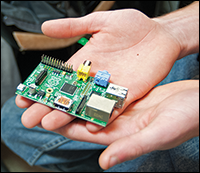|
A Slice of Raspberry Pi
Daniel Strain
High schoolers program small computers
to keep an eye on fish tanks

RICKY CATRON, TIM BOWERSOX, AND EMILY KEITH spend many mornings in a science lab tucked into a corner of North Carroll High School. Here, you can find a diverse array of equipment: computer monitors, an electronic device called a "breadboard" that's bursting with wires, and a fish tank complete with a toy tiki hut and a spotted goldfish named Bessie.
"This is our little lair," Catron says.

A team of students — Ricky Catron, Emily Keith, and Tim Bowersox (top, from left) — looks over code that they’ve written to program a Raspberry Pi, a small computer that can fit in the palm of your hand (bottom) but has versatile uses. Photographs: Daniel Strain
The three students, all seniors, are enrolled in Science Research. That's the name for a series of courses offered through all nine high schools in Maryland's Carroll County, including North Carroll. In these classes, students learn about science while raising populations of fish, turtles, crayfish, and other aquatic animals in a variety of fish tanks (see Bringing the Bay to the Classroom).
In the fall of 2014, Catron's group began a project to change how students collect water quality data from these fish tanks. The project blends engineering, computer programming, and marine biology. It's an excellent example of the diverse opportunities for students working in an aquaculture setting to learn about science, says James Peters, the science supervisor for Carroll County's high and middle schools.
One of the big problems with running a lab filled with fish tanks, Catron explains, is that aquaculture is finicky: if the oxygen levels in a tank's water supply get too low, or the temperature gets too hot, the fish inside can go belly up.
So he and his partners in crime are designing a system to monitor conditions in these tanks automatically. The key to their project is a small computer about the size of a drink coaster called a Raspberry Pi. This device shares its pastry-like name with its developer, a non-profit group called the Raspberry Pi Foundation that specializes in education. The students chose this computer because it's versatile — unlike a desktop computer, it's relatively easy to program a Raspberry Pi to complete various tasks.
Here's how the setup works: Catron, Bowersox, and Keith will connect a Raspberry Pi computer to sensors installed in a tank of their choosing. Then the students will program the Pi device to collect data streaming in from the aquarium and post it to a website at regular intervals. That way, if the water quality in the tank goes south, its keepers will know right away.
"We could send a text alert to their phone and say, 'Hey, this is going really bad, you need to get to your tank now before everything dies,'" Catron says.
In 2014 Catron, Bowersox, and Keith received $1,000 to complete their project as part of a workshop organized by Maryland Sea Grant to train teachers in the state about aquaculture education. They used those funds plus $200 of their own money to buy five Raspberry Pis and an assortment of temperature and oxygen sensors.
Once they've finished setting up all of the equipment, the group will be the first in Maryland to do this sort of water monitoring in a K-12 classroom setting, says Hannah McNett, who teaches Science Research at North Carroll. She says that the project shows what teenagers are capable of if they're allowed to take charge of their own educations. She's barely helped them at all this year. "It's all them," McNett says. "I'm just here."
|